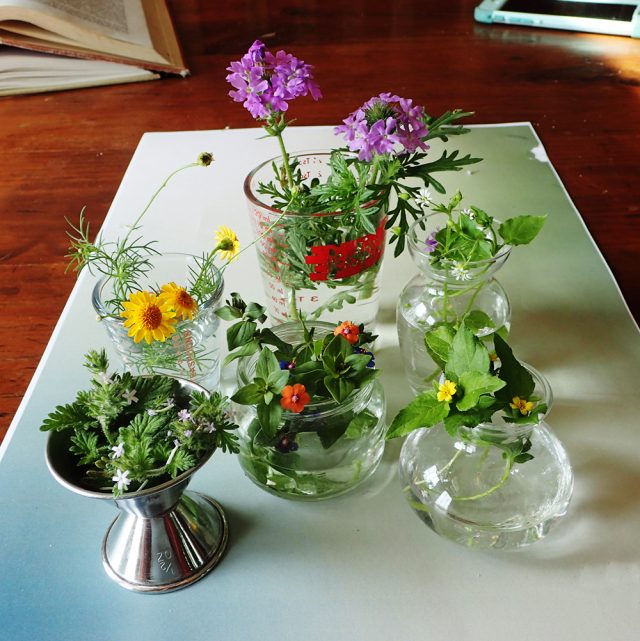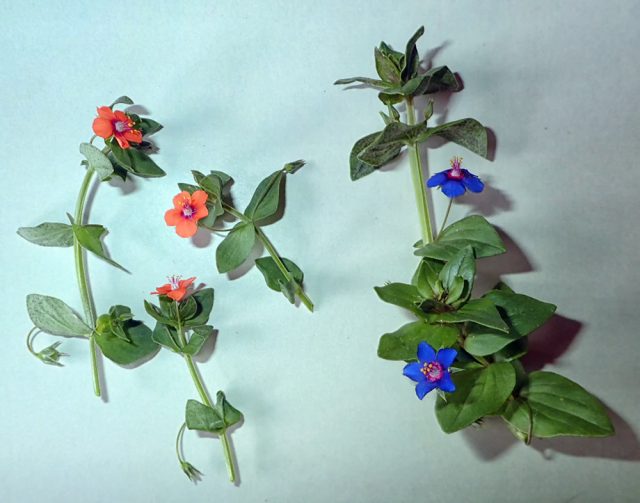03/03/017 – Teeny Tiny Blossoms Usher In Wildflower Season

This array of six tiny wildflowers can be found right now in just about every pasture, park and lawn. Clockwise from bottom left: Beaked Vervain, Golden Dyssodia, Dakota Vervain, Llovisna (native chickweed), Horseherb, and Scarlet Pimpernel (center front). Karen Benson Photo.
You can’t help but notice that Spring has arrived early in South Texas this year. Bluebonnets are popping up along roadsides, swallows are singing, and the live oaks are shedding their leaves. Things that normally happen in late March are happening now.
The past winter was very mild. A friend once quipped: “Winter occurs on a Thursday in South Texas.” He wasn’t far wrong this year! With only one exceptionally cold spell, it did not seem like winter at all.
So what does this mean for our much anticipated wildflower season? Billowing masses of Texas Bluebonnets and Indian Paintbrushes? A wide array of species we rarely see? Or a short period of a few flowers followed by an early summer?
I, for one, am hoping for a plethora of many colorful species, starting now and lasting until May. In fact, I have already begun to look. I am finding there are at least two dozen kinds of wildflowers in my pasture and yard. Most of them are quite tiny. Teeny, even.

Scarlet Pimpernel is red, of course, but it also has a blue-flowered form. There is some evidence that the blue form does better in South Texas’ sunny weather. Karen Benson Photo.
My favorite is Scarlet Pimpernel. This flower is native to Europe and the Mediterranean, but it has naturalized worldwide. Some might even call it a weed. Its name is due to its color of course, for it is most commonly red…in England at least. Scarlet Pimpernel also comes in salmon, peach, lilac, white and blue! The blue form is especially striking and there is some evidence that the blue flowered pimpernel favors sunnier habitats. The plant has the curious nickname of Poor Man’s Weather Glass. This is because pimpernel closes on cloudy days. I think it also folds up its petals in the late afternoon, so go looking for it early in the day!
As a kid, I heard people refer to “the Scarlet Pimpernel” as a person. Maybe he was a character like “Zorro” from some old movie. I definitely do not recall pimpernel being a plant! I finally researched it and found that the Scarlet Pimpernel was a fictional character created by Baroness Emma Orczy in a novel (1905) by the same name. Her character, Sir Percy Blakeney, was a chivalrous Englishman who went about rescuing aristocrats during the French Revolution. Blakeney would leave his calling card, emblazoned with a simple red flower (a Scarlet Pimpernel), at the scene of his exploits. The character actually got his name from the flower, not the other way around. How’s that for a bit of trivia for you?
Another little flower loves our dry soils. It is growing all over the pasture. It is a member of the Compositae, the sunflower family. Its common names are Tiny Tim, Dahlberg Daisy and Golden Fleece. These names give you an idea of its size, shape, and color. But I prefer Golden Dyssodia (the name I first learned for it.) Dyssodia is an excellent rock garden and xeriscaping plant. It forms low growing mounds of frilly foliage covered with half-inch wide yellow blooms. It is so popular that I have found it for sale in commercial nurseries.
No doubt you are familiar with a wild verbena that is common here. It is the purple Dakota Vervain. This verbena can grow rather tall, over a foot or so, with flower clusters almost two inches across. Right now most of the specimens are on the small side, though.
Whereas Dakota Vervain’s individual flowers are about a half-inch across, its cousin, Beaked Vervain, has flowers less than an eighth of an inch across. The tiny whitish-lavender flowers are borne on a stalk only a few inches tall. You really have to look to see this one!
Chickweed likes damp, shady places. You are likely to find this bright green plant with the delicate reclining stems and pretty, white blossoms in a flowerbed close to your house. Common Chickweed is a native of Europe but is a weed species in North America. Chickweed is edible, though, by humans and poultry alike. Our native chickweed is Prostrate Starwort. What an ugly name for a pretty plant! I like its Spanish name, Llovisna, which means drizzly rain.
Are you or your pets allergic to lawn grass? There is a plant that you can use to replace grass: It is Hierba del Caballo (Horseherb) or Straggler Daisy. This low-growing groundcover can be walked upon, played on, even mown. Plus, it not only takes the abuse, it flowers under it. Of course, the yellow flowers are minute, but still pretty. Horseherb is a sprawling perennial plant that even the botanists describe as “a troublesome lawn weed.” Remember, a weed is a plant that thrives where you do not want it. Maybe it is time to change our thinking on Horseherb!
These are just a few of the many little beauties in our yards and pastures in springtime. Go outside, look down, and see what you can find!
If you would like to offer comments, please click through to the discussion page
